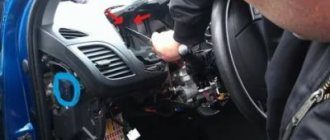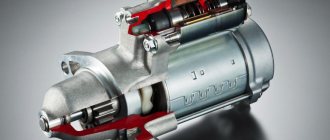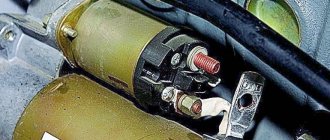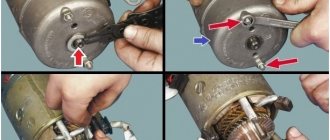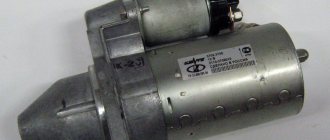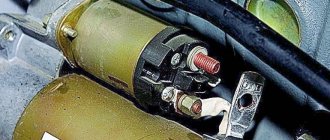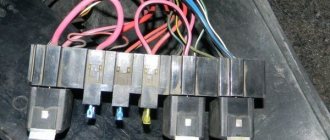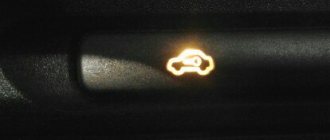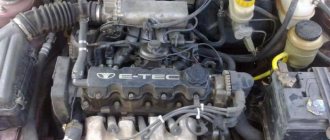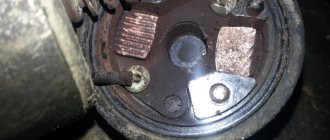The wiring diagram for hatchbacks 2112 is a unique thing in itself. In order for voltage to appear on the solenoid relay, the following parts must be in good working order: the ignition switch, the ECU unit and two more relays - the main and additional ones. Some cars do not have an additional relay, which can be considered good luck. But, if when you turn the key on a VAZ-2112 the starter does not turn, then the fault must be looked for in the wiring. A broken immobilizer code can also cause problems. The last malfunction can be cured by replacing the ECU or disabling the immobilizer. Well, let's look at something simpler.
The reader will be surprised, but there will be more than one scheme here. The most difficult option is shown below.
Scheme with an additional starter relay Please note: relay K2 is not at all “unloading”. A significant current flows through the lock contacts, and relay K2 can be called “blocking”: when it does not work, the starter does not turn. Why is this necessary, think for yourself.
If an attacker closes the contacts in the lock, he will not only be unable to start the engine, but also not use the starter. That is, the hijacker will not drain our battery. The circuit shown above is used with 1.6 liter injection engines. There may be another option - a simpler one.
Circuit without additional relay There is no blocking relay here. The current flows to the solenoid relay from pin 50. A simple version of the circuit is typical for cars from early years of production. Which applies to the entire “Ten” family, including hatchbacks. That is, an interesting combination occurs: the model is VAZ-2112, and the starter will turn even in the absence of all relays and ECUs!
The starter doesn't turn, what happens?
We know that there are two variants of the scheme. If “option 2” is implemented, voltage to the starter is supplied directly from the lock. But the ignition switch in the “Tens” is short-lived, since 30-40 Amperes are transmitted through it (the current of the solenoid relay).
This is true for both the sedan and the 2112 hatchback, and the starter may not turn only because the lock is broken. Draw your conclusions!
All of the above also applies to “diagram 1” - look at it carefully. The main relay is located in the extension block. It is located under the stove on the right.
An additional relay is located in the main unit (see photo). However, it may be missing.
If “option 2” is implemented, check only the lock. And if there is an additional relay, it is not recommended to install a jumper instead. Marked in the photo:
- Additional relay (white arrow);
- Main relay (element “6”).
Car engine starting mechanism
The car engine starting mechanism is a system that requires special attention and is directly responsible for starting the engine itself.
Modern cars are predominantly equipped with a starter engine starting system. The triggering mechanism is directly related to electrical equipment.
The mechanism is powered by direct current from the car battery. The trigger mechanism includes the following elements.
- Connecting wires.
- Starter.
- Egnition lock (
Final check before replacing the starter
We turn the key to position II, and nothing happens... In this case, open the hood and remove the air filter by unscrewing the screw on the body and loosening the clamp on the pipe. The starter is located under the filter housing. In the photo we see the following: someone disconnected the solenoid relay cord.
What we found under the filter, we check with a needle probe that when you turn the key, “+12” appears. Then, after checking, we wrap the cord with electrical tape.
Sometimes voltage seems to be supplied to the starter, but the solenoid relay is activated “every time”. Well, try cleaning the terminal - both in the connector and on the starter itself. Consider the situation:
- The copper is polished to a shine;
- The wire (see photo) is supplied with “plus”;
- The starter doesn't even click.
The first thing you need to check is the battery contacts. We remove the terminals (key “10”) and look at what is under them. There is no point in measuring the voltage with a probe - it will show “12 Volts”.
Solenoid relay current – 40 Amperes. The presence of a resistance of 0.1 Ohm results in a voltage drop of 4 Volts. So consider... And the starter motor consumes 200 Amperes during operation.
Posts 1 to 20 of 27
1 Topic by Dimon 2014-07-09 21:16:16 (2014-07-09 21:19:08 edited by Dimon)
- Daimon
- New member
- Inactive
- Registration: 2014-07-09
- Messages: 9 Thanks : 2
- Car: VAZ 2112
Topic: Solved: When you turn the key, the lights go out, but the starter does not turn
Gentlemen, hello everyone! I’m from 2112.ru, but I didn’t find a solution to the problem there
In short, the problem is like many others in this topic. You turn the key to start, the lights go out, but the starter does not turn, even the retractor does not click. I tried to measure the voltage on the red wire when turning the key, there is voltage, 12.5 volts. At first I made a mistake with the retractor, but with a screwdriver (by bridging the contacts on the starter) the car starts perfectly. That is, the starter is completely alive. The problem does not appear every time and appears mainly when it is hot. That is, you turned off the car, for example, went to the store for 5 minutes, came back, and it wouldn’t start. I have to get under the hood with a screwdriver.
Guys, where to dig. Shall we think together? The voltage at the moment of turning the key seems to come to the starter (this means the ignition switch is alive), it starts with a screwdriver (this means the starter is alive). Why doesn’t the key turn or even click?
2 Reply from igorek 2014-07-09 21:22:59
- igorek
- Brother-in-law
- Inactive
- From: Bryansk region g Starodub
- Registration: 2013-05-05
- Messages: 416 Thanks : 191
- Car: VAZ-21102 1.5i-8V Bosch MP7.0H
Re: Solved: When you turn the key, the lights go out, but the starter does not turn
Daimon , come here with your problem, it was discussed here. The starter does not turn when the engine is warm (after a trip)
3 Reply from Dimon 2014-07-09 21:41:20
- Daimon
- New member
- Inactive
- Registration: 2014-07-09
- Messages: 9 Thanks : 2
- Car: VAZ 2112
Re: Solved: When you turn the key, the lights go out, but the starter does not turn
igorek , I know about additional relays, additional buttons and other “crutches”. But these are crutches! I want to figure out the problem so that everything works as expected. And on all sites it usually ends up installing additional. relay
(
4 Reply from iliaBkmz 2014-07-09 21:48:40
- iliaBkmz
- Forum legend
- Inactive
- Registration: 2012-11-12
- Posts: 2,042 Thanks : 584
- Car: outlander and 2104
Re: Solved: When you turn the key, the lights go out, but the starter does not turn
the Daimon starts with a screwdriver, but not with the key, then it most likely needs to be changed. Moreover, if +12 comes to the small wire - in the start position. But it’s also worth checking the condition of the terminals on the battery and the condition of the terminals on the retractor.
5 Reply from Dimon 2014-07-09 21:52:15 (2014-07-09 21:52:48 edited by Dimon)
- Daimon
- New member
- Inactive
- Registration: 2014-07-09
- Messages: 9 Thanks : 2
- Car: VAZ 2112
Re: Solved: When you turn the key, the lights go out, but the starter does not turn
iliaBkmz , and how to explain this? The retractor doesn’t like +12 coming from the wire, but at the same time likes +12 from the screwdriver?
Why doesn't the starter turn over?
Depending on what caused the starter to fail, it is necessary to take the next steps - repair or replace the unit. In addition, in some cases, you do not need to repair the starting device itself, but manipulate other components. In most cases, you can get by with repairs, but experienced car enthusiasts recommend immediately replacing the unit so that there are no more problems with it.
- Most VAZ-2110s do not have a standard injector, but many car enthusiasts install this unit themselves. It helps reduce fuel consumption, helps start the engine in cold weather without warming up and increases power. The injector fails, and along with it the starter, due to low-quality fuel. Another reason may be failure to follow the connection diagram, but then you will discover a malfunction immediately after installing the injector. Otherwise, you need to flush the injector to remove any suspended matter that is carried into it by the fuel.
- If the car starts, but after a short stop the engine cannot be restarted, then the problem lies in the overrunning clutch. At the moment of failure, you may hear clicking sounds from under the hood and notice that the car radio begins to turn on by itself. In this case, you need to cool the power unit before restarting or not make short stops. You will also need to replace the overrunning clutch with its geared counterpart. Be sure to check the conductors that come from this node. Sometimes, to restore the functionality of the coupling, it is enough to replace the wires that visually look damaged.
- The retractor part of the starter especially often fails. When such a breakdown occurs, the dashboard lights first light up and then go out. Before replacing the solenoid relay, you must close the starter and turn off the alarm. If the listed components are in working order, then you will simply have to replace the relay.
- Clicking sounds in the starter and failure to start the engine are often caused by damaged contacts. In this case, first inspect the battery, clean the terminals if oxide appears on them. Sometimes on a VAZ-2110 it is enough to tap the starter relay to get rid of the problem. Be sure to take an assistant with you who will start the engine while you tap the relay. If with such a rough approach it was possible to start the engine, then it is worth replacing the relay completely. Repair will be impractical.
- An unexpected engine stop is caused by problems with the immobilizer. You will not be able to start the engine because the protection is triggered. This only happens on injection VAZ-2110s. It is impossible to fix the problem on your own; call a tow truck and go to the nearest service station, where they will be able to restore your car’s functionality.
Starter and retractor
It was said above that the first thing to check is the solenoid relay. However, it is no less important to test the starter itself, especially if the above checks did not yield anything. The best remedy is to install a known working starter and check how everything works.
Thus, it becomes clear why the starter starts every other time. The reason for this is either the contacts, the fuses, or the starter itself.
Forget about fines from cameras! An absolutely legal new product - Traffic Police Camera Jammer, hides your license plates from the cameras that are installed in all cities. More details at the link.
- Absolutely legal (Article 12.2);
- Hides from photo and video recording;
- Suitable for all cars;
- Works through the cigarette lighter connector;
- Does not cause interference to radios and cell phones.
| The battery is faulty or completely discharged | Charge the battery or replace it |
| The battery terminals and wire tips are heavily oxidized; tips are loosely tightened | Clean the pole terminals and wire lugs, tighten and lubricate with Vaseline |
| Interturn short circuit in the pull-in winding of the traction relay, its short circuit to ground or open circuit | Replace the traction relay |
| Open circuit in the power supply circuit of the starter traction relay | Check the wires and their connections in the circuit between plugs “50” of the starter and the ignition switch |
| The contact part of the ignition switch is faulty: contacts “30” and “50” do not close | Replace the contact part of the ignition switch |
| Traction relay armature jammed | Remove the relay, check the ease of movement of the armature |
| Battery is faulty or discharged | Charge the battery or replace it |
| The battery terminals and wire tips are oxidized; tips are loosely tightened | Clean the pole terminals and wire lugs, tighten and lubricate with Vaseline |
| The lugs of the wire connecting the power unit to the body are loose | Tighten the wire lugs |
| The contact bolts of the traction relay are oxidized or the nuts securing the wire lugs to the contact bolts are loose | Clean the contact bolts, tighten the wire fastening nuts |
| Burnt commutator, stuck brushes or worn out brushes | Clean the commutator, replace the brushes |
| Open or short circuit in the armature winding | Replace anchor |
| Low battery | Charge the battery |
| Open or short circuit in the holding winding of the traction relay | Replace the traction relay |
| Large voltage drop in the power circuit of the traction relay due to severe oxidation of the wire tips | Check the wires and their connections in the circuit from the battery to plug “50” of the starter |
| Freewheel slipping | Check the starter on the stand, replace the clutch |
| Reducer gears are damaged | Replace damaged gears |
| Excessive wear of armature and drive shaft bearing shells | Replace liners or covers and supports with liners |
| The starter is loose or its cover on the drive side is broken | Tighten the mounting nuts or replace the starter |
| The starter is fixed skewed | Check the starter mounting |
| Reducer gears are damaged | Replace damaged gears |
| Damaged drive gear teeth or flywheel ring gear | Replace drive or flywheel |
| The gear does not disengage from the flywheel: – the clutch is stuck on the drive shaft splines – the traction relay armature is stuck | Do the following: – clean the splines and lubricate them with engine oil – replace the traction relay or eliminate the jam |
How to accurately determine that the starter needs to be replaced
It is not always worth wasting your time to fix a faulty starting device with minor or partial repairs. Large-scale troubleshooting is often impractical at this site. Before removing, let alone disassembling, the starter, you need to remember three signs when you should rush to purchase new spare parts:
- When you turn the key in the ignition, you hear a grinding noise in the engine compartment area. This directly indicates a malfunction of the bendix (overrunning clutch) or flywheel. It is these parts that need to be replaced.
- Clicking noises when the starter fails to operate means the relay is faulty.
- A strained engine start is evidence of failure of the starter brushes.
The most common cause of clicking sounds in the starter is considered to be a failure of the retractor. The relay is not that expensive, and you can also try to fix it yourself. This will require a lot of effort, but will save you from replacing the unit. Just remember that this is a temporary measure, the restored relay will not be enough for a long time, and in some cases the bulkhead will not help.
Under the relay body you can find the armature, coil, rod and contacts. Most often, oxide appears on parts of this device, which is time to try to clean. However, it is worth remembering that this measure is sometimes ineffective. Therefore, it is best to immediately buy a new spare part.
Popular causes of malfunction
The most common reasons account for about 95% of all cases when the starter does not turn. That’s why we pay attention to them first.
The starter does not turn differently in different situations. It is important to take this into account and clearly monitor all associated symptoms. So, even without the help of specialists, you will be able to return the unit to operation and resume normal operation of the ignition system
| Situation | Probable Causes |
| There is one click, after which the starter goes silent. |
|
| Multiple clicks occur in succession |
|
| Clicks are completely absent, as are other signs of starter life. |
|
Bendix
Often, simply disassembling and cleaning the internal components of the starter can eliminate problems with its functionality. Therefore, after removing the device and not finding damaged elements inside it, try to thoroughly clean everything, assemble it and put it back in place. It is likely that the starter will start turning.
How much does it cost to replace a starter?
Beginning car enthusiasts often have questions after visiting a parts store. Most often they are interested in why relays have very different prices. First of all, it is worth remembering that spare parts for the VAZ-2110 are manufactured not only by domestic factories, so you can find relays under brands such as BOSCH or Tomahawk. They are more expensive than those produced in Russia. At the same time, domestic ones have a better price-quality ratio. Brands such as VIS or Torgmash will cost you much less.
If you prefer to install original components from AvtoVAZ (often in stores they are labeled “made in Tolyatti”), then the relay will cost you about 1,000 rubles, and the entire starter – 5,000. Domestic manufacturers of spare parts can offer you more budget options. The price may be half as low, but the quality is not always worthy. Imported analogues, on the contrary, are twice as expensive, so a starter from BOSCH can be found for 10 thousand rubles, a relay will cost about 2,000.
All features of the standard scheme
The reader will be surprised, but there will be more than one scheme here. The most difficult option is shown below.
Scheme with an additional starter relay Please note: relay K2 is not at all “unloading”. A significant current flows through the lock contacts, and relay K2 can be called “blocking”: when it does not work, the starter does not turn. Why is this necessary, think for yourself.
If an attacker closes the contacts in the lock, he will not only be unable to start the engine, but also not use the starter. That is, the hijacker will not drain our battery. The circuit shown above is used with 1.6 liter injection engines. There may be another option - a simpler one.
Circuit without additional relay There is no blocking relay here. The current flows to the solenoid relay from pin 50. A simple version of the circuit is typical for cars from early years of production. Which applies to the entire “Ten” family, including hatchbacks. That is, an interesting combination occurs: the model is VAZ-2112, and the starter will turn even in the absence of all relays and ECUs!
Options for developing situations
• Spark is present on the spark plugs of all cylinders. This is already a good sign. Let's proceed to the next point.
• There is a spark on the first and fourth cylinders, but no spark on the others. Conclusion: ignition coil 2112 does not work.
• There is a spark on the second and third cylinders, but no spark on the others. The conclusion is the same as in the previous paragraph. The ignition module should also be replaced. When after replacing this element the problem does not go away, the culprit is a malfunction of the output keys to the ignition module from the electronic control unit. Repairing the unit will solve this problem.
• When there are no sparks at all, the most likely reason may be a breakdown of the crankshaft position sensor, from which the commands for its formation come.
